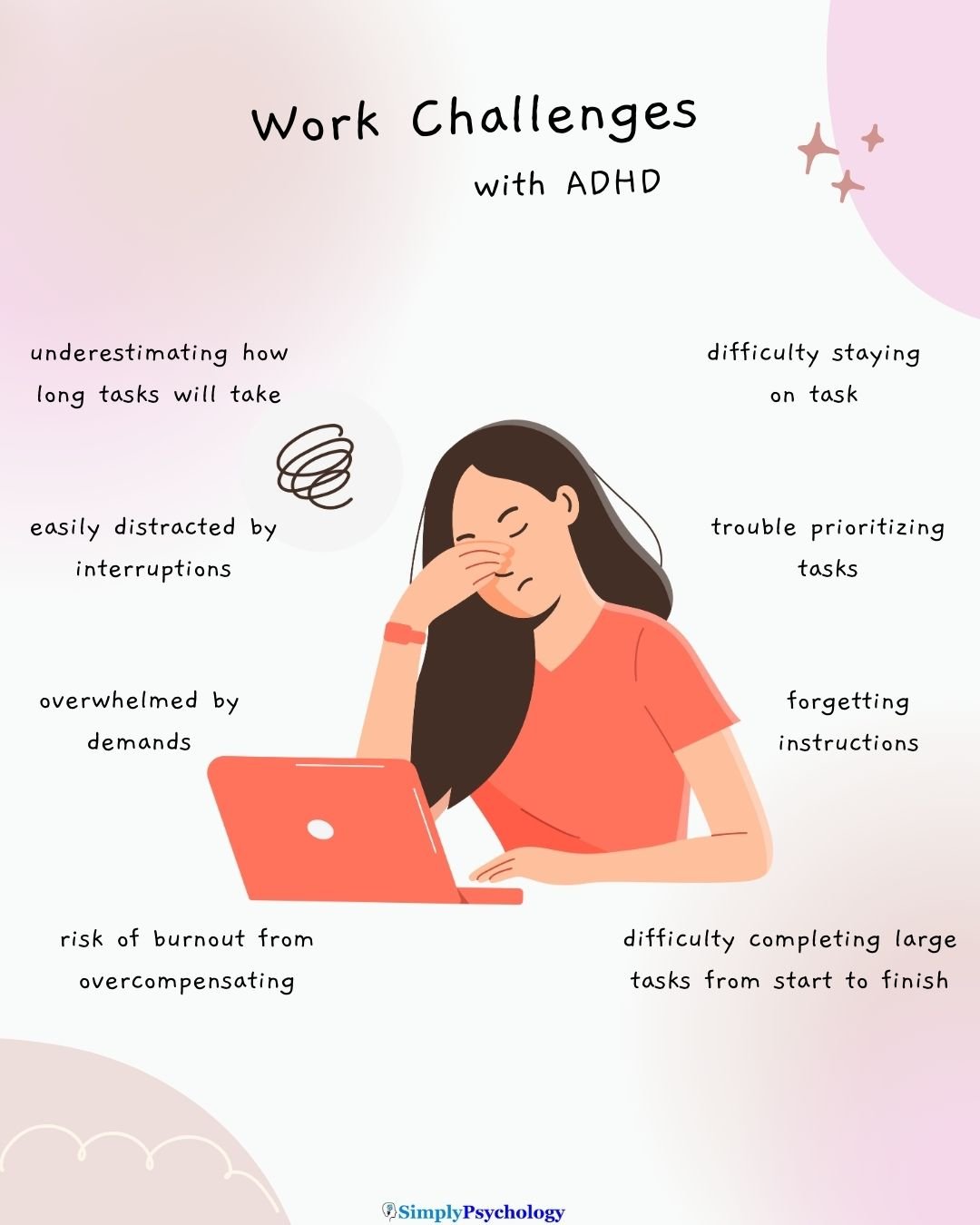Many adults with ADHD find the workplace especially challenging. Difficulties with organization, prioritization, time management, and focus can make everyday tasks more stressful and sometimes lead to misunderstandings with colleagues or managers.
At the same time, ADHD is linked with creativity, energy, and problem-solving skills that can be invaluable in the right setting.

This article looks at how ADHD symptoms show up at work, why certain environments make them harder to manage, the emotional and career impact they can have, and practical strategies and supports that can help employees with ADHD succeed.
How ADHD Symptoms Show Up in the Workplace
Adults with ADHD often face challenges in executive functioning—the mental skills needed to organize, initiate, plan, and see through tasks.
In the workplace, this can mean forgetting steps in a process, misestimating how long something will take, or feeling overwhelmed when multiple tasks are demanded at once. These difficulties aren’t personal failings but reflect how ADHD affects cognition.
For example, consider Alice, a content designer in a UK government department, who didn’t realise until her diagnosis that when she “can’t start” a long project, it’s not laziness but a difficulty breaking down large tasks into parts.
She found deadlines creeping up because she underestimated the prep work needed.
Common Challenges
- Focus and distractibility: The ADHD brain may latch onto something more interesting or urgent, so routine or “boring” tasks get sidelined or delayed. Notifications, colleagues dropping by, or even ambient noise can throw off concentration.
- Time management and meeting deadlines: Tasks often take longer than expected. Starting may be delayed by feeling unsure of where to begin. Deadlines may arrive suddenly because planning or estimating time didn’t account for all steps.
- Organization and prioritization: When many tasks are lined up, deciding what to do first can feel impossible. To-do lists may grow, and items get forgotten. Physical or digital clutter makes finding things harder, which creates extra delays.
Social and Communication Difficulties
In meetings, someone with ADHD might interrupt because they fear forgetting their thought. They might misread tone—assuming criticism where none was intended.
Details from discussions may be forgotten, leading to miscommunication. All this can strain working relationships: colleagues may feel unheard, feedback might be misinterpreted, and trust can erode without clear communication.
Other Workplace Challenges for Adults with ADHD
- Task Initiation – getting started on large or vague projects can feel daunting, leading to delays.
- Follow-Through – projects may be left unfinished, or enthusiasm fades once the novelty wears off.
- Switching Between Tasks – difficulty shifting attention smoothly can cause errors or wasted time.
- Memory Gaps – forgetting passwords, appointments, or routine steps, even in familiar tasks.
- Managing Stress – feeling overwhelmed by competing demands can trigger frustration or shutdown.
Why ADHD Causes Challenges at Work
Many of the difficulties adults with ADHD face at work stem from a mismatch between what ADHD brains need and what typical workplaces demand.
Tasks requiring sustained attention, frequent switching between tasks, meeting multiple deadlines, or handling vague instructions push those with ADHD harder than many other employees.
A large study of over 1,200 adults found that inattention symptoms were strongly linked with self-reported work-related problems, especially when people perceived they were underperforming relative to their own standards.
Role of the Environment
Work environments that expect multitasking, have open-plan offices, or bombard employees with constant digital notifications intensify challenges.
In a study of workers with ADHD symptoms, high job demands combined with low control over work and low social support correlated with much higher psychological distress.
Similarly, environments lacking clear structure exacerbate difficulties with planning and prioritization because people with ADHD thrive when there is order, predictability, and limits.
Impact of Stress and Comorbidities
Stress from trying to keep up, masking symptoms, or fear of negative evaluation can accumulate, leading to burnout.
ADHD often co-exists with anxiety and depression. Adults with ADHD plus a mood or anxiety disorder may have a larger burden: poorer quality of life, longer illness duration, and more obstacles to doing even “routine” work.
One qualitative study of Swedish adults emphasized that when organizational support is missing, stress becomes chronic and mental health worsens.
The Emotional and Career Impact
Many adults with ADHD experience profound emotional consequences at work. Constant struggles with meeting expectations—perceived or actual—can erode self-esteem.
People often feel shame or internalize criticism, sometimes hearing themselves described (or judging themselves) as “lazy,” “disorganized,” or “not trying hard enough,” even when they’re working extremely hard behind the scenes.
Because ADHD often requires continuous effort to compensate—double-checking work, masking difficulties, overworking to “keep up”—there is an increased risk of burnout.
A study found that the link between ADHD and burnout is mediated by deficits in executive functions (especially self-organization, time management, and planning).
As those internal compensatory efforts accumulate, so does exhaustion: emotional, mental, and cognitive fatigue begin to overwhelm.
Over time, these emotional stresses translate into career effects. People with ADHD may be more likely to switch jobs frequently, have poorer job stability, or experience stalled progression (e.g., fewer promotions).
In contexts lacking understanding or accommodations, many feel trapped in roles that under-utilize their strengths.
This turnover and underachievement aren’t due to lack of ability, but more often a lack of fit, support, or recognition.
Strengths People With ADHD Bring to Work
While ADHD is often discussed in terms of its challenges, many of its traits carry unique strengths—especially when aligned with the right job, environment, and mindset.
People with ADHD often score highly on creativity, divergent thinking, curiosity, resilience, and energy.
One of the most notable strengths is hyperfocus: when working on tasks that genuinely interest them, many people with ADHD can enter a state of deep concentration and high productivity, tuning out distractions.
These strengths shine particularly well in roles or settings that are dynamic, allow variety or novelty, or play to creative problem-solving.
For example, people with ADHD may thrive in roles like design, marketing, education, journalism, emergency services, software development, or roles with startup culture where quick thinking, adaptability, and new ideas are at a premium.
Strategies for Managing ADHD at Work
Self-Management Strategies
One of the most effective ways for someone with ADHD to reduce workplace stress is by using tools that externalize the burden of executive functions.
Timers, alarms, and apps (such as to-do lists, visual task boards) help make time visible and build reminders.
For example, time-blocking or the Pomodoro Technique—working in short, focused bursts with regular breaks—can improve focus and reduce fatigue. These techniques may enhance productivity in people with ADHD.
Body doubling is another helpful strategy: having someone else nearby (physically or virtually) while you work allows for external accountability and helps reduce procrastination.
Structuring the workday is crucial:
- Break large, vague tasks into small, concrete steps
- Schedule periods of deep work when you’re most alert
- Insert short breaks to reset attention
- Limit multitasking by dedicating time slots to single tasks
- Use checklists to monitor progress and reduce overwhelm.
These self-management tools reduce the internal load of organizing and prioritizing.
Workplace Accommodations
In the UK framework for example, many accommodations fall under reasonable adjustments required by employers under the Equality Act 2010 for those with disabilities or long-term health conditions. ADHD may count, depending on its impact.
Some common, relatively simple accommodations include:
- Allowing flexible working hours or remote work so that tasks are done during more productive periods of the day.
- Creating quiet workspaces or permitting noise-cancelling headphones.
- Written instructions, breaking down tasks, checklists, or visual schedules to help with memory and clarity.
- Frequent shorter breaks to help reset focus.
When requesting accommodations:
- It helps to clearly describe what difficulties are arising, and what support has helped in the past (or could help).
- An employee doesn’t always need a formal diagnosis to request adjustments under some countries’ law.
- Employers are legally obliged to make reasonable adjustments if they know (or should reasonably know) about the impairment and its effects.
Support and Professional Help
For many, self-management and workplace changes are greatly enhanced by professional support.
ADHD coaching can help build personalized strategies for organization, time management, and self-regulation.
Therapy (such as cognitive-behavioural therapy) addresses emotional issues like shame, anxiety, or imposter syndrome.
In many cases, medication may play a role in reducing core symptoms, thereby making strategies more effective.
If undiagnosed, seeking a professional assessment is valuable—not just to access medication or formal accommodations, but also to understand one’s pattern of strengths and challenges; this insight underpins more effective self-management, better communication with employers, and better mental health outcomes.
How Employers and Colleagues Can Help
Employers and colleagues play a pivotal role in easing ADHD-related challenges and allowing employees to thrive.
One of the most important things managers can do is to ensure clear communication, set priorities, and give frequent feedback.
For example, having regular one-to-one check-ins to clarify what “urgent” means, agreeing on the top 2–3 objectives for the week, and offering feedback not just on what needs improving but what is going well. This clarity can greatly reduce ambiguity and anxiety.
Reducing stigma and encouraging disclosure are equally critical. Many UK employees worry about being viewed as less capable or that disclosure might harm their career.
Employers can build trust by ensuring confidentiality, treating shared ADHD status sensitively, and making it clear that reasonable adjustments are legal and expected.
Building inclusive teams means valuing neurodivergence, not just tolerating it. This could involve training for staff to understand different communication styles, recognizing diverse working patterns (e.g., need for quiet work time, breaks, flexible hours), and normalizing reasonable adjustments.
Employers might also foster peer support or neurodiversity networks so employees with ADHD can share what works for them, reducing isolation. Organizations that do this often report better retention and higher morale.
References
Fu, X., Wu, W., Wu, Y., Liu, X., Liang, W., Wu, R., & Li, Y. (2025). Adult ADHD and comorbid anxiety and depressive disorders: A review of etiology and treatment. Frontiers in Psychiatry, 16, 1597559. https://doi.org/10.3389/fpsyt.2025.1597559
Fuermaier, A. B., Tucha, L., Butzbach, M., Weisbrod, M., Aschenbrenner, S., & Tucha, O. (2021). ADHD at the workplace: ADHD symptoms, diagnostic status, and work-related functioning. Journal of Neural Transmission, 128(7), 1021-1031. https://doi.org/10.1007/s00702-021-02309-z
Nagata, M., Nagata, T., Inoue, A., Mori, K., & Matsuda, S. (2019). Effect Modification by Attention Deficit Hyperactivity Disorder (ADHD) Symptoms on the Association of Psychosocial Work Environments With Psychological Distress and Work Engagement. Frontiers in Psychiatry, 10, 409557. https://doi.org/10.3389/fpsyt.2019.00166
Turjeman-Levi, Y., Itzchakov, G., & Engel-Yeger, B. (2024). Executive function deficits mediate the relationship between employees’ ADHD and job burnout. AIMS Public Health, 11(1), 294. https://doi.org/10.3934/publichealth.2024015

